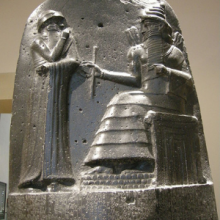Browse
Middle East

Review
United Nations Children’s Fund (UNICEF)
Teachers of modern history and regional or world geography will find a wealth of primary sources on this site that can contribute to filling in a realistic picture of children's situations and the economic, public health, scientific, social, cultural, and political issues that affect them, as
Review
The International Children's Digital Library
The International Children's Digital Library is a feast for children who are bookworms. It is also a treasure trove for teachers of reading, literature, science, social studies, and world cultures or geography. Scholarly researchers will find in its global collection a wealth of material for
Teaching
Short Teaching Module: Hammurabi's Code
An extremely useful source for discussions of Mesopotamian government and society is the Babylonian document Hammurabi’s Code (circa 1780 BCE).

Source
The Code of Hammurabi
This source is a part of the Hammurabi's Code teaching module.

Review
Internet Ancient History Sourcebook
This site was designed to provide classroom teachers with an extensive, well-organized collection of ancient Mediterranean literary texts and, to a lesser extent, art and archaeological sources.
Review
Oriental Institute Museum Photographic Archives
These photographs are invaluable sources for teachers who wish to illustrate lessons about the ancient civilizations of the Middle East or discussions about archeological research.
Review
Great Archaeological Sites
The sites are not designed as collections of primary materials (though much primary visual and archaeological data is embedded), but as synopses of particular topics, sites, or excavations. With this in mind, any of these sites would be an excellent place for students to learn the basics of a
Review
National Security Archive: Sources on Europe
These materials help students discover that history does not follow a predetermined course, but is the result of decisions, any one of which could drastically alter history’s outcome.
Review
Foreign Relations of the United States, Volume XVII: Near East, 1961-1962
These documents provide crucial historical evidence of the attitudes American diplomats and officials held toward the countries of the Middle East, as well as uncovering aspects of foreign relations from an American perspective at the height of the Cold War.Teaching
Long Teaching Module: Women in the Islamic World, 600-1600
From its inception in the early 7th century up to the present day, women have played a vital role in shaping Islamic history.